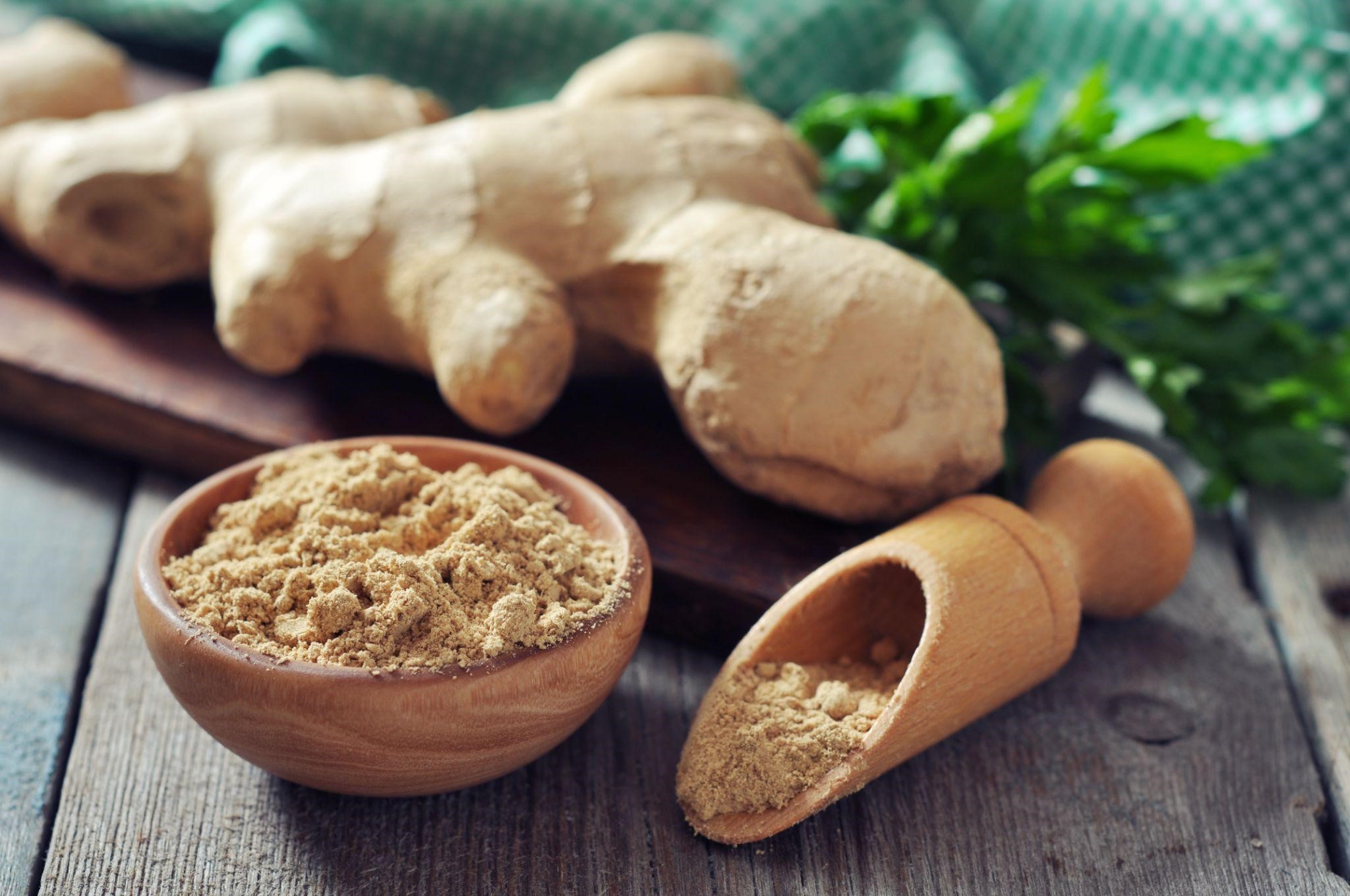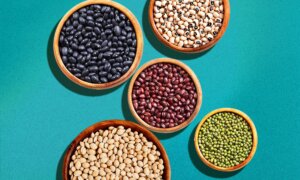Accidentally eating contaminated food or experiencing an allergic reaction can cause serious discomfort. While seeking medical attention is crucial, certain traditional Chinese medicine (TCM) remedies may help provide first aid and relieve symptoms.
Food poisoning cases frequently make headlines. In November 2024, a major E. coli outbreak linked to McDonald’s locations across the United States was suspected to have been caused by contaminated onions. The outbreak resulted in more than 100 infections, with at least 34 hospitalizations and the death of one older adult. Another incident involved at least 48 people falling ill after eating E. coli-contaminated organic carrots, leading to 20 hospitalizations and one death.
The most common symptoms of E. coli infection include stomach cramps, diarrhea, vomiting, and, in rare cases, hemolytic uremic syndrome, a serious kidney condition.
Food safety risks often stem from:
- Raw or undercooked meat or seafood contaminated with bacteria or parasites
- Leftovers that have been contaminated with bacteria
- Moldy food due to improper storage
- Allergic reactions triggered by seafood, nuts, or other allergens
The severity of food poisoning symptoms depends on several factors, including age, overall health, the cause of poisoning, and the amount of toxins ingested. Those with weaker immune systems may experience more severe symptoms.
Symptoms typically appear within one to 36 hours after eating contaminated food, with vomiting and diarrhea being the most common. Other symptoms may include nausea, fever, headache, fatigue, and, in severe cases, bloody or pus-filled stools.
On the other hand, food allergies can cause skin redness and swelling, nasal congestion, asthma, and digestive discomfort. Some people may also experience dizziness, anxiety, or irritability. In severe cases, allergic reactions can lead to breathing difficulties, heart palpitations, shock, or even loss of consciousness.
First Aid for Food Poisoning
If you suspect that you or someone else has food poisoning, consider taking the following steps:
Preserve a Food Sample and Seek Medical Attention
If symptoms of food poisoning develop, seek medical help immediately. At the same time, keep any remaining uneaten food, seal it, and store it in a cool place—but do not freeze it—as it may be needed for testing. In most cases, hospitals will notify the relevant health authorities.
Use Vinegar to Regain Consciousness
If the person has lost consciousness, soak a gauze pad or cloth in vinegar and place it over his or her nose. The strong smell of vinegar may help the person regain consciousness.
Induce Vomiting
If the contaminated food was eaten within the past few hours, the toxins may still be in the stomach. Inducing vomiting can help expel the harmful substances and reduce toxin absorption. This can be done by stimulating the back of the tongue with a finger, the handle of a spoon, or chopsticks. Alternatively, drinking salt water (dissolve about 1 tablespoon of salt in 3/4 of a cup of warm water, then let it cool) or ginger juice may help trigger vomiting.
Be Cautious With Anti-Diarrheal Medication
Diarrhea is a common symptom of food poisoning and can help flush toxins from the body. Taking anti-diarrheal medication too soon can hinder the body’s natural detox process. It is generally best to avoid such medication unless diarrhea is excessive (occurring more than 10 times in a day) and causing severe dehydration or weakness.
Get Plenty of Rest and Stay Hydrated
After food poisoning, rest and hydration are essential. Drink plenty of fluids and eat small, light meals to avoid overburdening the digestive system. If you have no appetite, try to eat small amounts of food while ensuring adequate fluid intake.
Home Remedies for Mild Cases
For mild cases of food poisoning or allergic reactions, certain kitchen ingredients may help alleviate symptoms:
Ginger
If you accidentally eat spoiled food, eating ginger immediately afterward may help prevent diarrhea or allergic reactions. Fresh ginger can be juiced and mixed with water or boiled into a tea to counteract fish and shellfish poisoning.
Ancient civilizations have long recognized the detoxifying properties of ginger. Ginger contains multiple antimicrobial compounds with broad-spectrum inhibitory effects on foodborne microorganisms.
Aloe Vera
Aloe vera is rich in bioactive plant compounds, including amino acids, vitamins, polysaccharides, and minerals, which can gently
stimulate bowel movement and help expel toxins.
In TCM, aloe vera is considered cooling in nature and may help alleviate acute inflammation.
Coriander
The distinct aroma of coriander may paralyze intestinal parasites, aiding in their elimination. It also stimulates the gastric nerves, promoting digestion and appetite.
An in vivo study found that adding cilantro to pig feed helped combat parasites. Additionally, a 2020 study showed that cilantro essential oil inhibited bacterial and fungal growth on bread.
Mung Beans
Mung beans are a nutrient-rich food. A
review indicated that mung beans contain various phytochemicals, including flavonoids and phenolic acids, which exhibit antimicrobial, antioxidant, and anti-inflammatory properties. They may also help reduce the absorption of toxic substances in the body.
Mung beans are an effective and versatile detoxifier. In cases of organophosphate pesticide poisoning, lead poisoning, or accidental drug overdose, eating a bowl of mung bean soup before reaching the hospital can serve as an emergency first-aid measure. Adding licorice root to the soup while it is cooking can further enhance its detoxifying effects. Additionally, mung bean soup is also known to help reduce alcohol intoxication.
Mung beans can also be cooked with rice to make porridge, which is particularly refreshing in the summer when experiencing dry mouth and thirst. This porridge not only is soothing, but also has detoxifying properties.
Mung Bean Porridge
Ingredients
- 5.3 ounces mung beans, soaked overnight in cold water and refrigerated
- 1.1 ounces Japonica rice, soaked in cold water for 30 minutes
- Rock sugar to taste
Preparation
- Bring a pot of water to a boil and add the mung beans. Cook over high heat, stirring for 3 minutes.
- Reduce heat, cover, and simmer for 30 minutes.
- Add the soaked rice and stir clockwise for 3 minutes.
- Cover again and cook over low heat for another 30 minutes until the mixture turns cloudy.
Green Tea
Drinking a cup of strong tea may help relieve symptoms of food poisoning. A 2022
study found that catechins and other compounds in tea can disrupt bacterial cell membranes, inhibiting common foodborne bacteria such as E. coli, Staphylococcus aureus, and Salmonella. The study indicated that green tea is more effective than black and oolong tea.
Perilla
Perilla has been widely used in TCM to
treat seafood poisoning and allergic reactions. For example, a patient developed skin allergies resembling hives after eating seafood. I measured 30 grams (1.05 ounces) of dried perilla leaves and instructed the patient to boil them in 1000 milliliters (about 4 cups) of water. After drinking perilla tea for a day, the patient found that symptoms significantly improved. After drinking another dose the next day, the patient found that symptoms disappeared without the need for antihistamines.
Perilla Tea
Ingredients
- 30 grams (1.05 ounces) dried perilla leaves
Preparation:
- Bring 1000 milliliters (about 4 cups) of water to a boil in a pot.
- Add the dried perilla leaves and simmer for no more than 10 minutes.
- Strain before serving.
Acupoints for Relieving Digestive Discomfort
For digestive discomfort caused by food poisoning, stimulating the following acupoints may help relieve symptoms:
Zusanli Acupoint
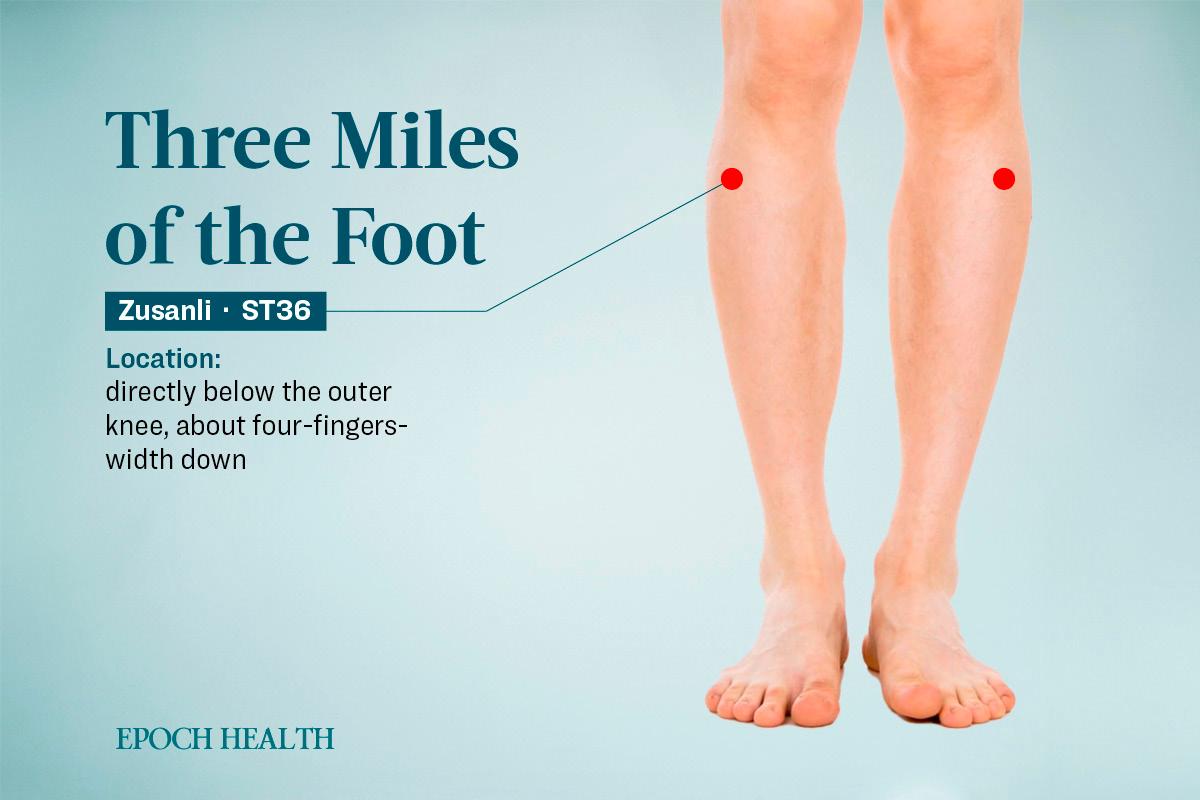
Location of the zusanli acupoint. (The Epoch Times)
Benefits: This acupoint helps boost immunity and regulate the spleen and stomach.
Zhongwan Acupoint
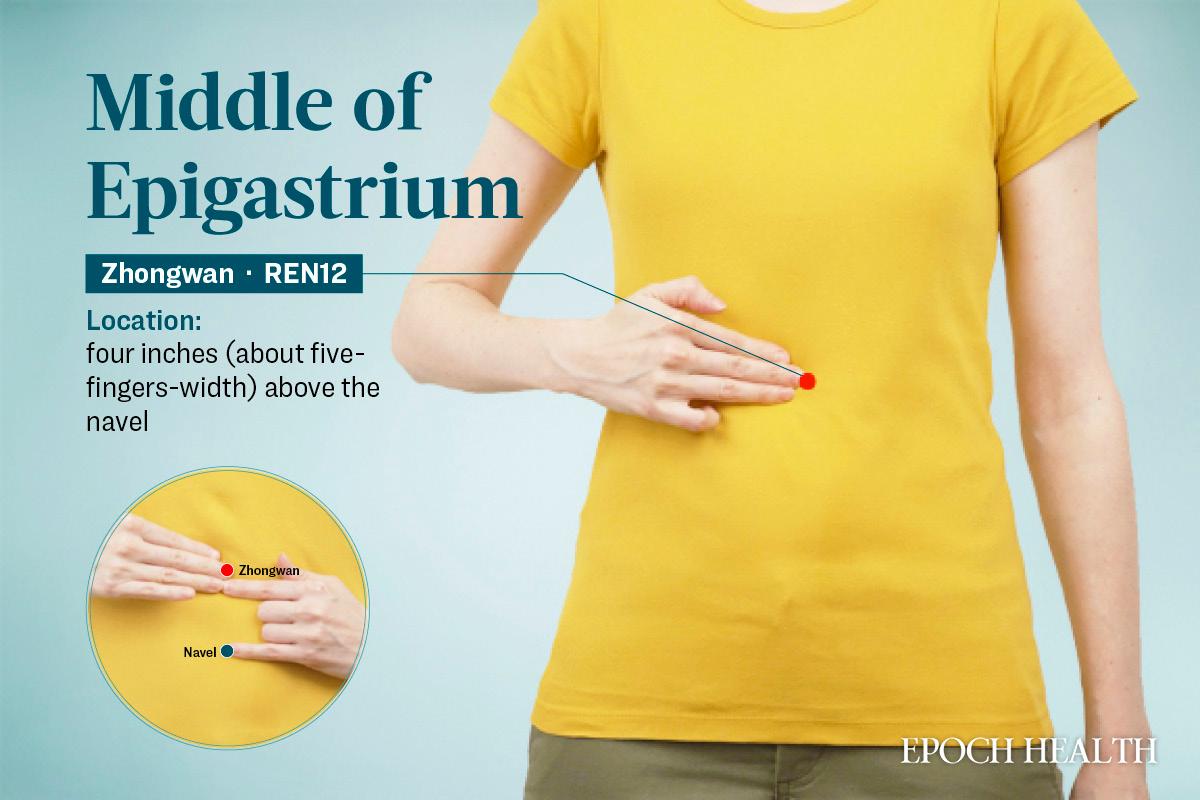
Location of the zhongwan acupoint. (The Epoch Times)
Benefits: This acupoint enhances gastric motility and is commonly used to treat digestive disorders such as bloating, diarrhea, and abdominal pain.
Neiguan Acupoint
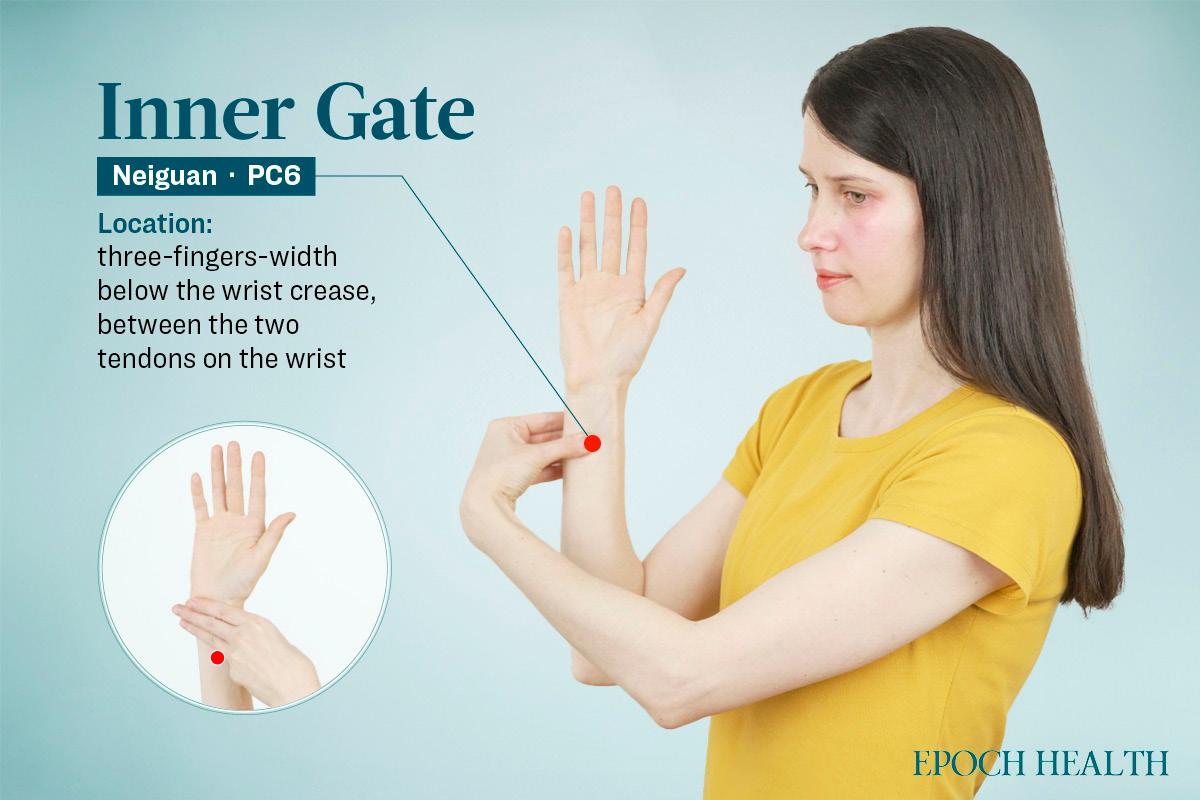
Location of the neiguan acupoint. (The Epoch Times)
Benefits: This acupoint is linked to the heart, chest, and stomach and may help alleviate nausea and vomiting.
Yongquan Acupoint
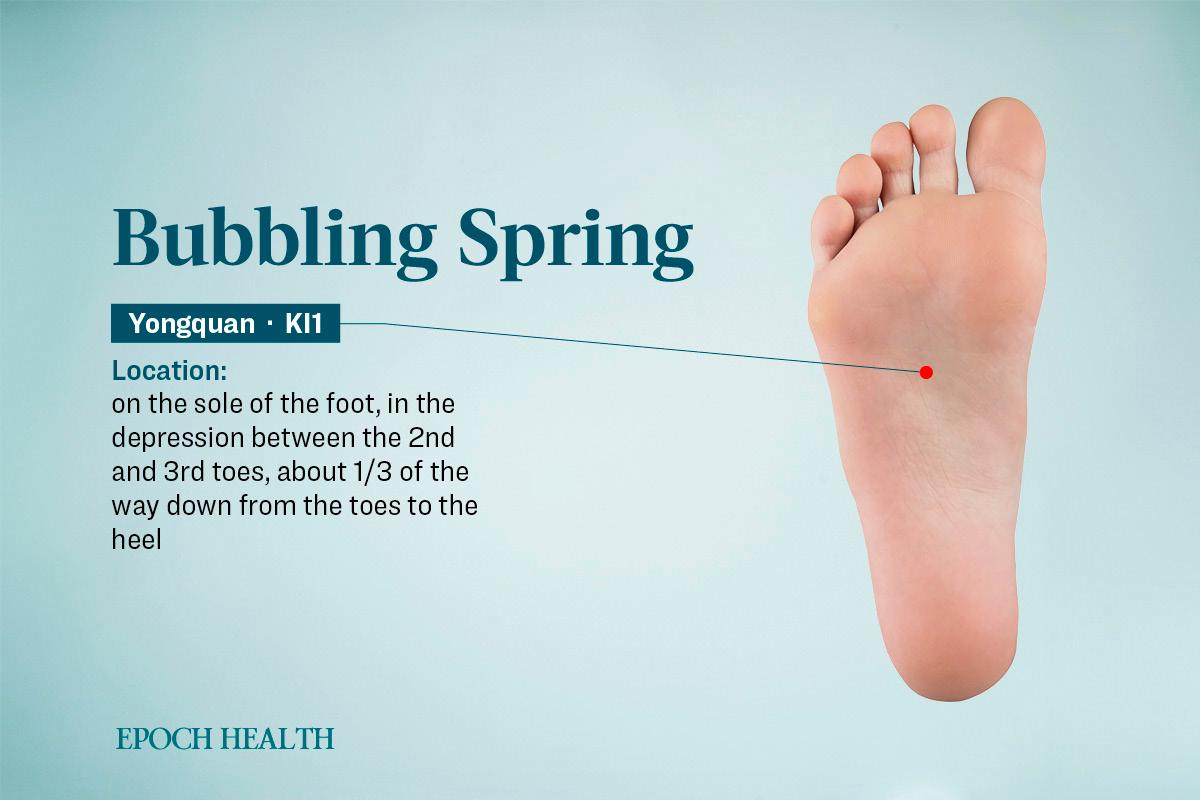
Location of the yongquan acupoint. (The Epoch Times)
Benefits: This acupoint is essential for kidney health and can also help reduce vomiting and diarrhea related to digestive issues.
Acupoints for Relieving Itchiness From Food Allergies
To relieve itchy skin caused by food allergies, try stimulating the following acupoints:
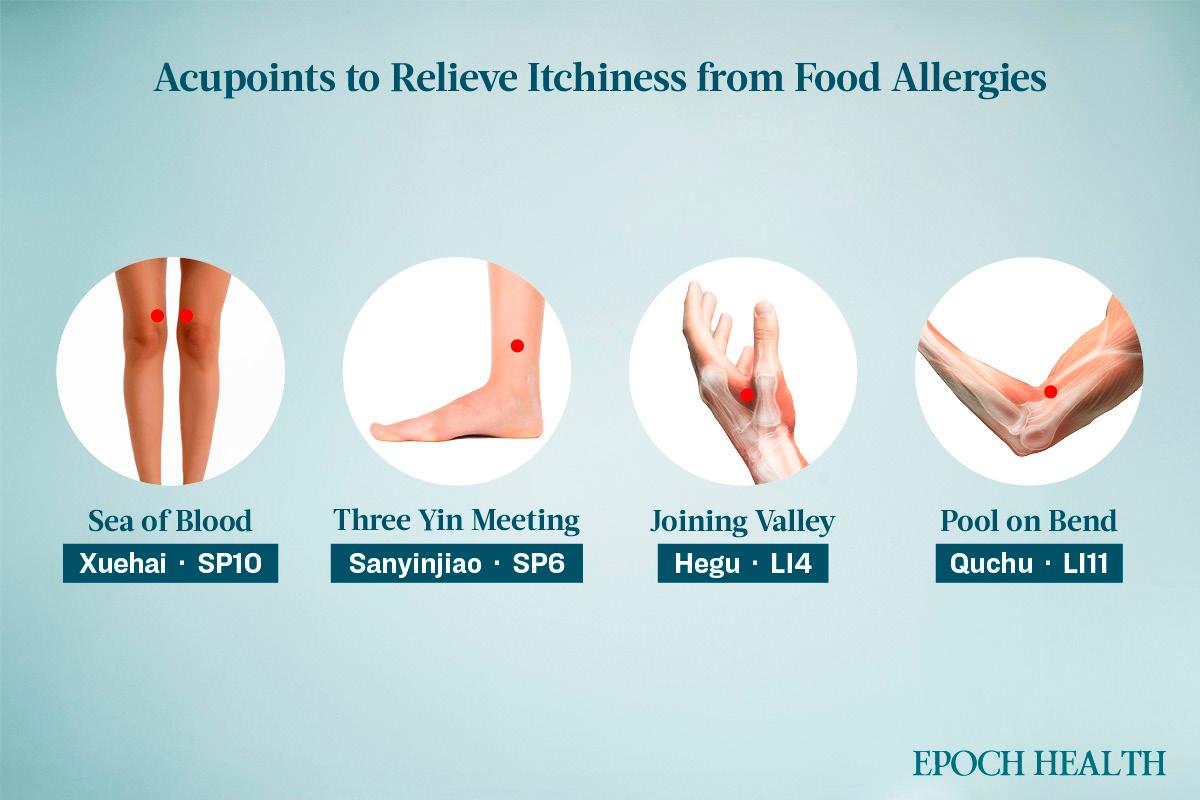
Acupoints for relieving itchiness from food allergies. (The Epoch Times)
Xuehai acupoint: Located two inches above the inner edge of the upper border of the kneecap, at the bulge of the inner thigh muscle.
Sanyinjiao acupoint: Located on the inner side of the lower leg, about the space of four fingers above the tip of the inner ankle, in the depression along the back of the tibia.
Hegu acupoint: Located in the hollow area between the first and second metacarpal bones, near the index finger.
Quchi acupoint: Located in the depression on the outer edge of the transverse crease of the elbow, near the edge of the bone.
Tips for Preventing Food Poisoning
To avoid eating contaminated food, keep the following precautions in mind when preparing meals:
Check the texture and smell of food. Always check the texture, color, and smell of food before eating. Do not eat if you notice discoloration, a slimy or sticky texture, or an unusual odor.
Keep raw and cooked foods separate. Use separate cutting boards and knives for raw and cooked foods to prevent cross-contamination.
Cook seafood thoroughly. There are several misconceptions about cooking seafood. For example, many believe shellfish are safe to eat as soon as their shells open while cooking. However, boiling them for at least 10 more seconds is best to ensure that they are fully cooked.
Rinsing seafood with salt water is not sufficient to kill bacteria. Vibrio parahaemolyticus, a common bacterium in seafood, thrives in salty environments. Using salt water will not eliminate it.
Similarly, wasabi and lemon juice cannot kill parasites in raw fish. Thorough cooking remains the most effective way to prevent foodborne illnesses.
Understand the food danger zone. Bacteria multiply rapidly between 40 and 140 degrees Fahrenheit. In general, food should be heated above 160 degrees F to kill bacteria. However, heating alone cannot eliminate all toxins—Staphylococcus aureus, for example, produces heat-resistant toxins. Leaving food at room temperature for too long allows bacteria to grow. Therefore, it is best not to leave food at room temperature for more than two hours—or more than one hour in summer.
Common Foodborne Viruses and Bacteria
According to statistics from the Taiwan Food and Drug Administration, the following are five of the most common causes of food poisoning:
Norovirus: Common sources are leafy greens, fresh fruits, shellfish, and contaminated water.
Staphylococcus aureus: Common sources are meat, dairy products, puddings, pastries, and sandwiches.
Bacillus cereus: Common sources are leftover rice, sausages, thick soups, sauces, jams, salads, puddings, and dairy products. This bacterium is heat-resistant, and eating reheated leftover rice is a common cause of infection.
Salmonella: Common sources are raw or undercooked chicken, eggs, unpasteurized milk and juice, and raw fruits and vegetables.
Vibrio parahaemolyticus: Common sources are raw or undercooked seafood, especially oysters.





